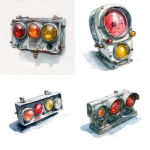Explore the Best AI Image Gallery

Beyond Reality: Exploring VR and ARs Impact on Gaming and Creativity
The gaming landscape is undergoing a seismic shift with the emergence of virtual reality (VR) and augmented reality (AR). These immersive technologies are not just revolutionizing how we play games but are also profoundly impacting the creative industry, opening up unprecedented opportunities for innovation and expression.
A New Era of Immersive Gaming
VR and AR transport players into entirely new worlds, blurring the lines between the digital and physical realms. VR headsets offer a fully immersive experience, placing users within virtual environments where they can interact with objects and characters in real-time. AR, on the other hand, overlays digital elements onto the real world through devices like smartphones or smart glasses, enriching our perception of reality.
The Creative Canvas Unleashed
VR and AR are empowering game developers to create more engaging and interactive experiences. They allow for:
- Enhanced Storytelling: Immersive environments can transport players deeper into narratives, fostering a stronger emotional connection with characters and storylines.
- Interactive Worlds: Players can actively shape their gaming experience by interacting with objects, solving puzzles, and making decisions that influence the outcome of the game.
- Unconventional Gameplay: VR and AR enable entirely new gameplay mechanics, such as physical movement within virtual spaces or manipulating objects in the real world through AR interfaces.
Transforming the Creative Industry
The impact of VR and AR extends beyond gaming, influencing various aspects of the creative industry:
- Film and Television: VR can provide immersive behind-the-scenes experiences, allowing viewers to step into movie sets or explore virtual worlds alongside characters.
- Art and Design: Artists are using VR and AR to create interactive installations, 3D sculptures, and augmented reality artworks that respond to viewer interaction.
- Architecture and Engineering: VR allows architects and engineers to visualize and experience building designs in a realistic way before construction begins.
Ethical Considerations
As with any emerging technology, VR and AR raise ethical concerns that need careful consideration:
- Data Privacy: VR and AR devices collect vast amounts of user data, raising concerns about privacy and how this information is used.
- Health and Well-being: Prolonged use of VR can lead to motion sickness or eye strain. Its essential to ensure responsible usage guidelines and promote well-being.
- Accessibility: VR and AR technologies should be accessible to people with disabilities, ensuring inclusivity and equitable access to these immersive experiences.
The Future of VR and AR
The future of VR and AR in gaming and the creative industry is brimming with possibilities:
- Enhanced Realism: Advances in haptics, sensory feedback, and artificial intelligence will create even more realistic and immersive experiences.
- Social VR: VR platforms will become increasingly social, allowing users to connect, collaborate, and interact with each other in virtual worlds.
- Convergence of Technologies: VR and AR will likely merge with other technologies like blockchain, cloud computing, and the metaverse, creating even more innovative applications.
As these technologies continue to evolve, they hold the potential to transform how we create, consume, and interact with digital content. The future of gaming and creativity is undoubtedly immersive, engaging, and boundless.
](https://images.ai-img.art/thumbnails/150/1d7b3a908141474d50d90721c394db29c0cb5404d685ae70ea60430c18e905b7.webp)


](https://images.ai-img.art/thumbnails/150/8c320ce9aefbbb5b9ec5fd4e1d0fba7388f0fff5b6c2e2f14077cad3008f291d.webp)
](https://images.ai-img.art/thumbnails/150/3c5dc62bba83cc9919c20ebfec8430d31e821cef586a2753dd85ef26d77d480a.webp)







](https://images.ai-img.art/thumbnails/150/3e8c063b4357fc743a3c6e49a3145ee31b2dcecc018c38d2db8f97bf3e3fda3f.webp)









](https://images.ai-img.art/thumbnails/150/1accb5453f2335686b162f0a879c7ce73a18516a33868f214a16bdaf95beeb5a.webp)
